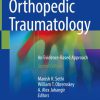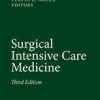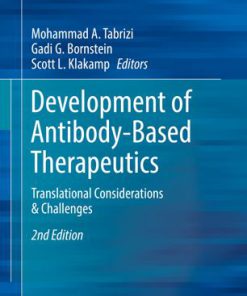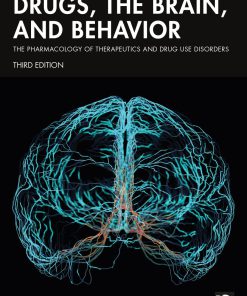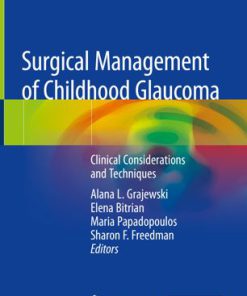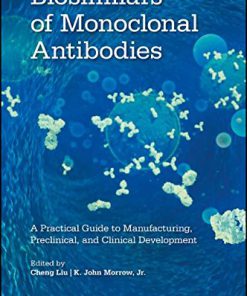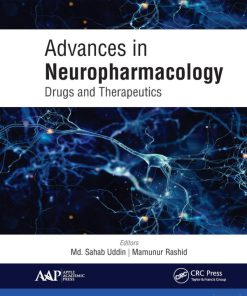Oligonucleotide based drugs and therapeutics preclinical and clinical considerations for development 1st Edition by Nicolay Ferrari, Rosanne Seguin ISBN 9781119070306 1119070309
$50.00 Original price was: $50.00.$25.00Current price is: $25.00.
Oligonucleotide based drugs and therapeutics preclinical and clinical considerations for development 1st Edition by Nicolay Ferrari, Rosanne Seguin – Ebook PDF Instant Download/Delivery: 9781119070306 ,1119070309
Full download Oligonucleotide based drugs and therapeutics preclinical and clinical considerations for development 1st Edition after payment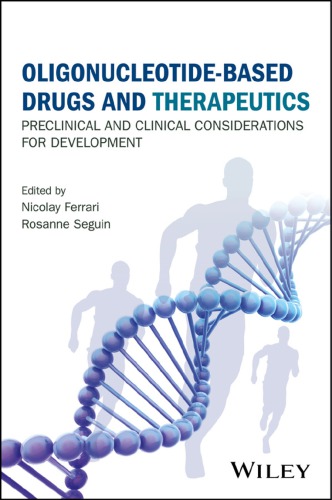
Product details:
ISBN 10: 1119070309
ISBN 13: 9781119070306
Author: Nicolay Ferrari, Rosanne Seguin
Oligonucleotide based drugs and therapeutics preclinical and clinical considerations for development 1st Edition Table of contents:
1 Mechanisms of Oligonucleotide Actions
1.1 Introduction
1.2 Antisense Oligonucleotide Therapeutics
1.3 Oligonucleotides that Sterically Block Translation
1.4 Oligonucleotides that Act Through the RNAi Pathway
1.5 Chemical Modification of siRNAs and miRNAs
1.6 Clinical Use of Oligonucleotides that Act through the RNAi Pathway
1.7 Oligonucleotides that Modulate Splicing
1.8 Conclusions
References
2 The Medicinal Chemistry of Antisense Oligonucleotides
2.1 Introduction: The Antisense Approach and the Need for Chemical Modification
2.2 Why Chemically Modify an Oligonucleotide?
2.3 Chemical Modifications of Current Importance by Structural Class
2.4 Conclusion
References
3 Cellular Pharmacology of Antisense Oligonucleotides
3.1 Introduction
3.2 Molecular Mechanisms of Antisense Oligonucleotides
3.3 Cellular Pharmacology of Antisense Oligonucleotides
3.4 Conclusion
References
4 Pharmacokinetics and Pharmacodynamics of Antisense Oligonucleotides
4.1 Introduction
4.2 Pharmacokinetic Properties of Antisense Oligonucleotides
4.3 Pharmacodynamic Properties of Antisense Oligonucleotides
4.4 PD and PK Results and Strategies of ASOs in Clinical Development
4.5 Summary and Conclusions
References
5 Tissue Distribution, Metabolism, and Clearance
5.1 Introduction
5.2 Tissue Distribution
5.3 Cellular Uptake
5.4 Metabolism and Clearance
5.5 Conclusion
References
6 Hybridization‐Independent Effects
6.1 Background
6.2 Mechanisms of Hybridization‐independent Toxicities
6.3 Hybridization‐independent Effects Following Local Delivery of Oligonucleotides
6.4 Conclusion
References
7 Hybridization‐Dependent Effects
7.1 Introduction
7.2 Specificity Studies with ASOs
7.3 Implications of the Nuclear Site of Action of RNase H1
7.4 Mechanism of OTE
7.5 Determining the Extent that Accessibility, Affinity and, Mismatch Tolerance Contribute to Off‐target Activity
7.6 Consequences of Unintended Transcript Knockdown: In Vivo and In Vitro Toxicity
7.7 Identification and Evaluation of Putative OTEs
7.8 Summary
Acknowledgments
References
8 Class‐Related Proinflammatory Effects
8.1 Introduction
8.2 Proinflammatory Effects of ASO for Consideration in Drug Development
8.3 Conclusions
References
9 Exaggerated Pharmacology
9.1 Introduction
9.2 Regulatory Expectations
9.3 Scope of EP Assessment
9.4 EP Evaluation Strategies
9.5 Conclusions
References
10 Genotoxicity Tests for Novel Oligonucleotide‐Based Therapeutics
10.1 Introduction
10.2 Experience with ONs in the Standard Battery
10.3 OSWG Recommendation for Genotoxicity Testing of ONs
10.4 Triplex Formation
10.5 Impurities
10.6 Conclusions
Acknowledgments
References
11 Reproductive and Developmental Toxicity Testing Strategies for Oligonucleotide‐Based Therapeutics
11.1 Introduction
11.2 General Design of Reproductive and Developmental Toxicity Studies
11.3 Product Attributes of Oligonucleotide Drugs
11.4 The Role of Intended Pharmacology in Reproductive and Developmental Effects
11.5 Selection of Animal Species
11.6 Justification of Dosing Regimen
11.7 Exposure Assessment
11.8 Subclass‐specific Considerations
11.9 Conclusions
Acknowledgments
References
12 Specific Considerations for Preclinical Development of Inhaled Oligonucleotides
12.1 Background
12.2 Oligonucleotide Delivery Systems
12.3 Repeat‐dose Toxicity
12.4 Toxicokinetics
12.5 Safety Pharmacology
12.6 Additional Testing
12.7 Conclusion
References
13 Lessons Learned in Oncology Programs
13.1 Introduction
13.2 Clinical Development of First‐generation ASOs
13.3 Clinical Development of Second‐generation ASOs
13.4 Regulatory Considerations
13.5 Future Opportunities for ASOs as Therapeutic Agents for Cancer Treatment
References
14 Inhaled Antisense for Treatment of Respiratory Disease
14.1 Introduction
14.2 Atopic Asthma
14.3 Antisense Oligonucleotides in Animal Models
14.4 Clinical Data
14.5 General Conclusion
References
15 Antisense Oligonucleotides for Treatment of Neurological Diseases
15.1 Introduction
15.2 Potential ASO Therapies in Neurodegenerative Diseases
15.3 Conclusion
References
16 Nucleic Acids as Adjuvants
16.1 Introduction
16.2 Categories of Nucleic Acid Adjuvants
16.3 Conclusion
Acknowledgments
References
17 Splice‐Switching Oligonucleotides
17.1 Introduction of Splice Switching
17.2 Preclinical and Clinical Development of Splice‐switching Oligos
17.3 Future Directions
Conflict of Interest
Acknowledgments
References
18 CMC Aspects for the Clinical Development of Spiegelmers
18.1 Introduction
18.2 Technology (Mirror‐imaged SELEX Process) Selected Pharmaceutical Properties
18.3 Preclinical Efficacy Data for Spiegelmers
18.4 Clinical Development
18.5 CMC Aspects for the Development of Spiegelmers
18.6 Future Prospects for Spiegelmer Therapeutics
References
Index
People also search for Oligonucleotide based drugs and therapeutics preclinical and clinical considerations for development 1st Edition:
antisense therapies
antisense technology a review
the antisense strand
bsense bio therapeutics
Tags:
Nicolay Ferrari,Rosanne Seguin,Oligonucleotide,drug,therapeutics,preclinical,clinical,development
You may also like…
Uncategorized
Medicine
Sleep Disorders Medicine Basic Science Technical Considerations and Clinical Aspects Chokroverty
Medicine - Psychiatry
Uncategorized
Surgical Management of Childhood Glaucoma Clinical Considerations and Techniques Alana L. Grajewski
Medicine - Pharmacology
Education Studies & Teaching


